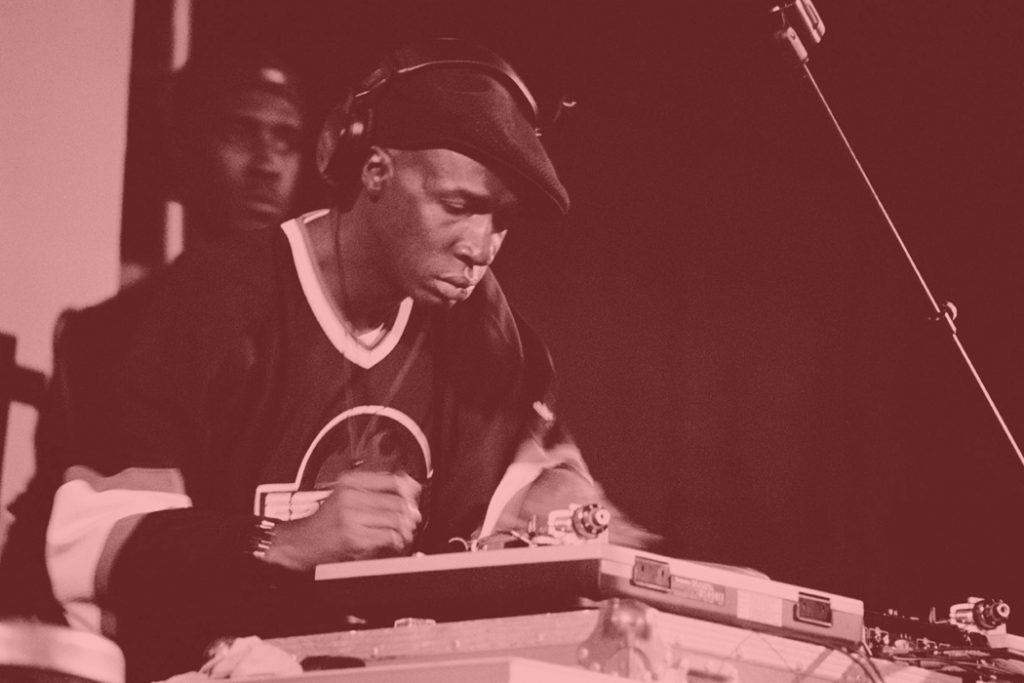+ Create and arrange original, instrumental hip-hop music from sampling pioneer RJD2 in his Soundfly course, RJD2: From Samples to Songs.
In the pursuit of new forms of creative expression, limitations can often lead to innovation. This was absolutely the case in the mid-1970s when DJs like DJ Kool Herc, Grandmaster Flash, Afrika Bambaataa, and more started to elevate the party experience by not only playing records, but manipulating them in real time.
The defunding of New York City public schools as well as massive housing projects in the Bronx and other areas of New York left many young people without access to traditional instruments or music education. This crisis luckily led a burgeoning crop of young DJs to embrace the turntable as their instrument; and music was changed forever.
It was actually Grandmaster Flash’s apprentice, Grandmaster Theodore, who first discovered the technique of scratching records by accident. The story goes he manually stopped a playing record with his hand to hear his mother calling him from another room. Once he heard the sound of the record scratching, a new sound was born.
Turntablism is the musical art form of scratching records and using the crossfader, found on most standard direct drive turntable setups to create new rhythms, sound effects, and compositional approaches by sampling and manipulating the audio on the records. This art form became synonymous with hip-hop in the 1980s and early ’90s, but was quickly overshadowed as audiences began focusing more on the emcees.
But music production continued to develop, and hip-hop continued to grow in popularity, and modern producers started crafting music that heavily relied on sampling, scratching, and manipulating records. DJ battles became international competitions and turntablism evolved as many DJs became performers in their own right after developing special techniques to take record scratching to new heights.
All of which have contributed to the legacy that continues today in instrumental hip-hop and beat making. Let’s look at some of the most influential turntablist records and tracks featuring DJs cutting it up on the 1’s and 2’s.
But first, if you’re producing hip-hop beats and looking for inspiration, creative alternatives, and to explore the work of one of the most influential beat makers of this century, look no further. Check out Soundfly’s course with turntablist and sampling pioneer, RJD2: From Samples to Songs — he explores his creative process in detail, breaks down some of his most famous beats, and flips samples in real time.
+ Enjoy access to Soundfly’s suite of artist-led music learning content for only $12/month or $96/year with our new lower price membership. Join today!

1. Grandmaster Flash – “Wheels of Steel”
Although Grandmaster Theodore discovered scratching, Grandmaster Flash brought the technique to a mainstream level. His early battles and live shows spread the sound of hip-hop DJing around New York City. He was also one of the first DJs to actually record scratching on audio recordings. “Wheels of Steel” showcases Grandmaster Flash mixing various records while also scratching in between transitions and executing rhythmic scratches to match the musical phrases. This record still stands as a testament to early hip-hop scratching and mixing techniques.
2. Herbie Hancock – “Rockit”
Herbie Hancock is a musical innovator most prominently known as a jazz pianist and composer. Yet he’s always embraced the forefront of electronic music technology and synthesizers, as far back as the early 1970s. On “Rockit,” Herbie utilizes all the modern innovations of the 1980s — drum machines, synths, and the prominent fixture of DJ scratching, none other than DJ Grand Mixer DXT. This song was a massive hit and did more than probably any other song before or after to popularize the turntables as a legitimate instrument in its own right.
3. Run D.M.C. – “Jam-Master Jay”
RUN D.M.C. is one of the most important hip-hop acts to arrive on the music scene in the 1980s. Their songs helped to push hip-hop straight to the mainstream, and their iconic style framed them as a dynamic trio of which the DJ was an integral part. The late Jam Master Jay was so important to the group that in addition to turntable work he played all of the instruments on the group’s groundbreaking album, Raising Hell — the first hip-hop record to reach platinum and multi-platinum album sales. The song “Jam-Master Jay” showcases the DJ’s mixing and scratching techniques that became a staple of the classic RUN D.M.C sound.
4. DJ Jazzy Jeff & The Fresh Prince – “A Touch of Jazz”
DJ Jazzy Jeff & The Fresh Prince became the first hip-hop act to win a Grammy Award. They also helped bring the turntable back to prominence in the late ’80s as Jazzy Jeff became an innovator of the transforming technique. Transforming is when a DJ moves the crossfader while simultaneously scratching the record to create a robotic sound that got its name for its resemblance to sounds from the 1980s cartoon series “The Transformers.” This song is a masterclass in this technique and a special DJ feature in a time where the music was beginning to be dominated by emcees.
5. Gangstarr – “DJ Premier in Deep Concentration”
DJ Premier is one of the DJs who made the transition to producer while still retaining his prowess as a DJ. He is known for being one of the producers who popularized the boom bap style of hip-hop production but his work as a DJ was a foundational part of Gangstarr’s group sound. This track showcases techniques such as mixing, transforming, chirping, and flares. These are all various techniques that rely on different combinations of using the crossfader as well as manipulating the direction of the record. DJ Premier is a master of various techniques as well as laying down neck-snapping breaks for rappers.
6. The X-Ecutioners (feat. Mike Shinoda & Mr. Hahn) – “It’s Goin Down”
The X-Ecutioners were a DJ crew that started in 1989 that originally boasted 11 members. The crew later reduced to Rob Swift, Roc Raida, Total Eclipse, and Mista Sinista, and became one of the first DJ groups to sign a major record deal. Their membership has since changed yet again, and Roc Raida passed away in 2009. The group has collaborated with Linkin Park, Run DMC, Kool G Rap, Cypress Hill, and many DJs throughout the turntablism community. The group became popular for their live shows in which they incorporated many new and unique turntable techniques, as well as solos, duos, etc. One of the techniques they became the most popular for is beat juggling, in which new beats are created using existing records, sometimes two copies of the same record, and other records to create new compositions.
Read our interview with Rob Swift here.
7. Cut Chemist – “The Audience is Listening Theme Song”
Cut Chemist rose to prominence as a member of the alternative hip-hop collective Jurassic 5 in the late ’90s. The group actually formed at the legendary Los Angeles club The Good Life; a breeding ground for many West Coast emcees in the early ’90s. After his departure from Jurassic 5 however, Cut Chemist released his critically acclaimed solo album, The Audience’s Listening. This track showcases Cut Chemist’s mastery of layering multiple samples in an organic way while still mixing in tasteful cuts that remind the listener that the DJ is controlling the show. This track is a prime example of how cutting vocal loops and other previously recorded music can create a completely unique song that is more than just derivative of the original samples.
8. Quasimodo (prod. Madlib) – “Microphone Mathematics”
Madlib is one of hip-hop’s most prolific producers. He’s collaborated with essential hip-hop greats like J Dilla, Kendrick Lamar, Kanye West, Freddie Gibbs, MF Doom, and so many more. However, one of his too-often overlooked projects is his moniker, Quasimoto, Madlib’s rap alter ego that features him rapping with a pitch-shifted voice to sound like a cartoon character. “Microphone Mathematics” is one of my favorite tracks from Quasimodo’s debut LP, The Unseen, and features a sample from De La Soul’s “The Bizness.” It’s this sample in particular that Madlib uses as the main tool to cut throughout the song. The album itself is a collage of field recordings, jazz samples, and obscure soundtracks that sound like they were pulled from the most eclectic record collection of all time!
9. DJ Shadow – “Building Steam With a Grain of Salt”
DJ Shadow is a prolific producer and DJ who has had a hand in defining a completely unique sample-based sound since the early ’90s. Shadow first made his name doing remixes for various artists, but it was his debut album, Endtroducing…., that first put him in the spotlight. This album is in the Guinness World Records book for “First Completely Sampled Album.” He famously made this record using nothing but an Akai MPC and a turntable. “Building Steam With a Grain of Salt” is a standout track from the project and, as with all the songs on the record, is built using a combination of various obscure records to create a musical collage that is a completely unique composition.
10. RJD2 – “Ghostwriter”
Turntablist and producer Ramble Jon Krohn, better known as RJD2, is the lead instructor of Soundfly’s brand new course on creative sampling and arranging techniques using records, an Akai MPC, a DAW, and the power of your imagination. RJD2 helped to define the alternative hip-hop sound of the early ’00s, and his debut album, Deadringer, signalled a change of tone in the scene with a more cinematic musical experience that combines samples from various genres into a sonic melting pot. RJD2’s music has been featured in films, commercials, and TV, most notably being adapted as the main theme music for the television show, Mad Men. This track, “Ghostwriter” features RJD2 matching Brazilian samba guitar, choral vocals, and a tightly sampled beat with tasteful overdubs everywhere. There are subtle scratches in the record that accent the rhythms of the shifting drum patterns everywhere, and his entire catalog highly rewards close repeated listens. Deadringer cemented RJD2 as a master of sample work and took the DJ/Producer album to new heights of exploration.
Ready for even more?
Check out Soundfly’s variety of courses on songwriting, mixing, beat making, recording, composing, and more, led by artists like Kimbra, Com Truise, Jlin, Kiefer, The Pocket Queen, and RJD2: From Samples to Songs.




